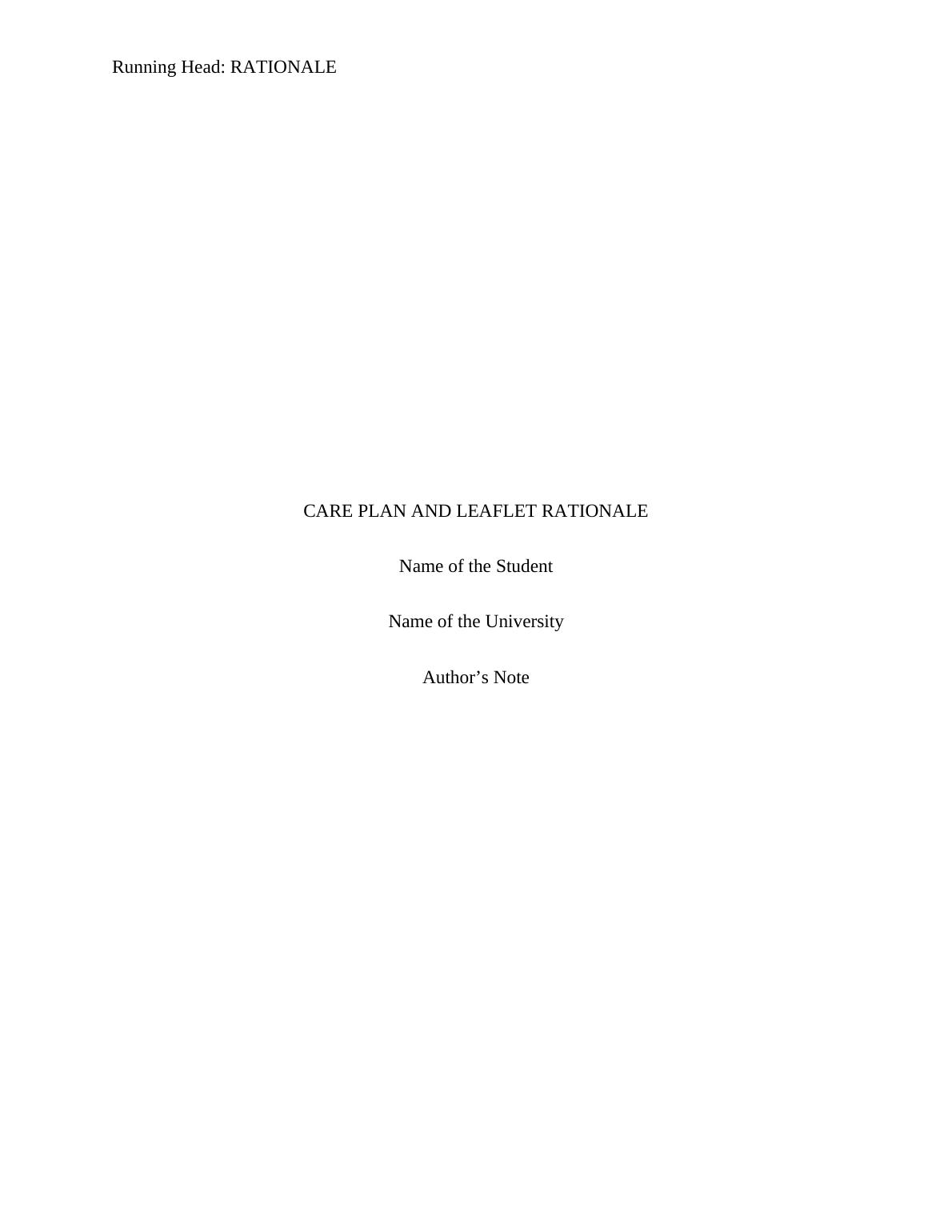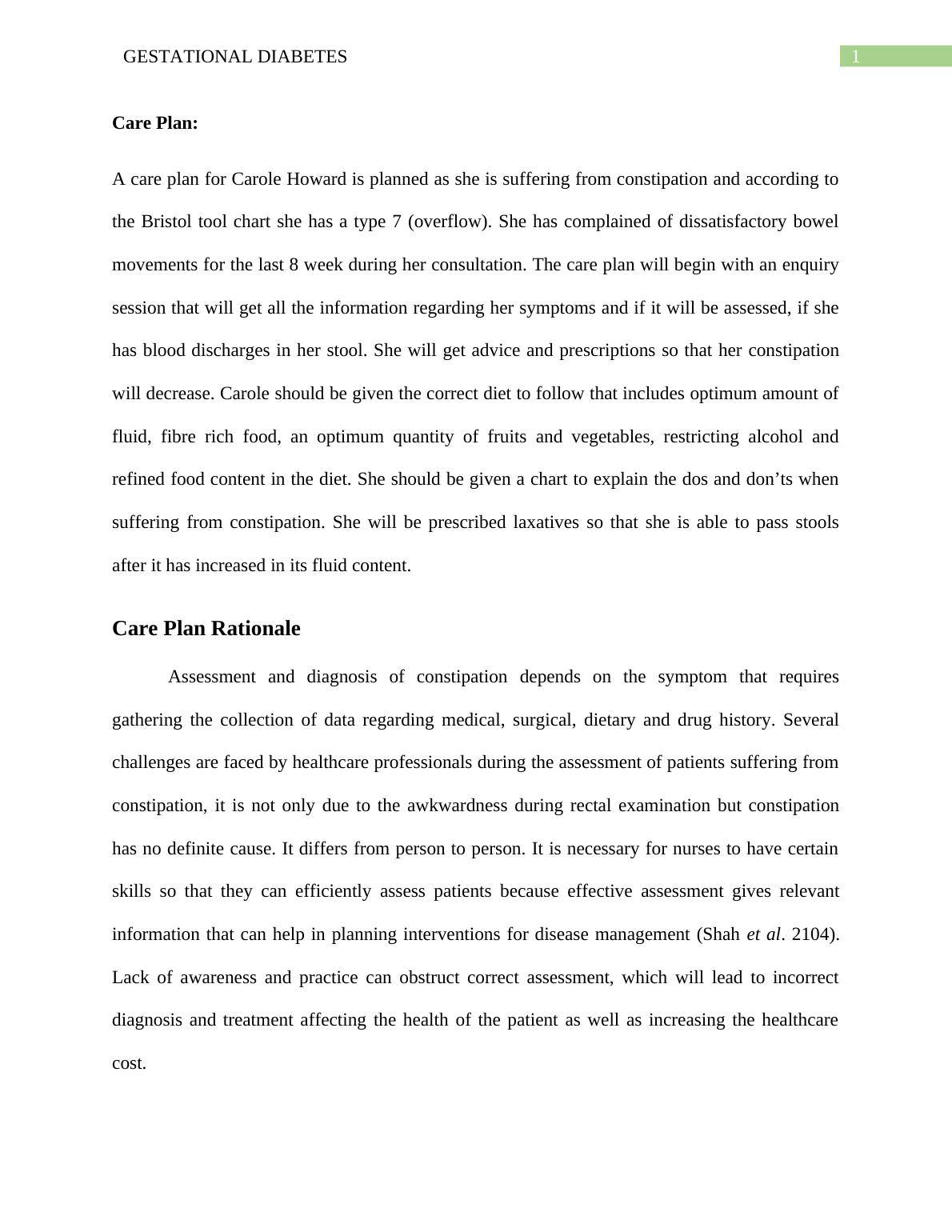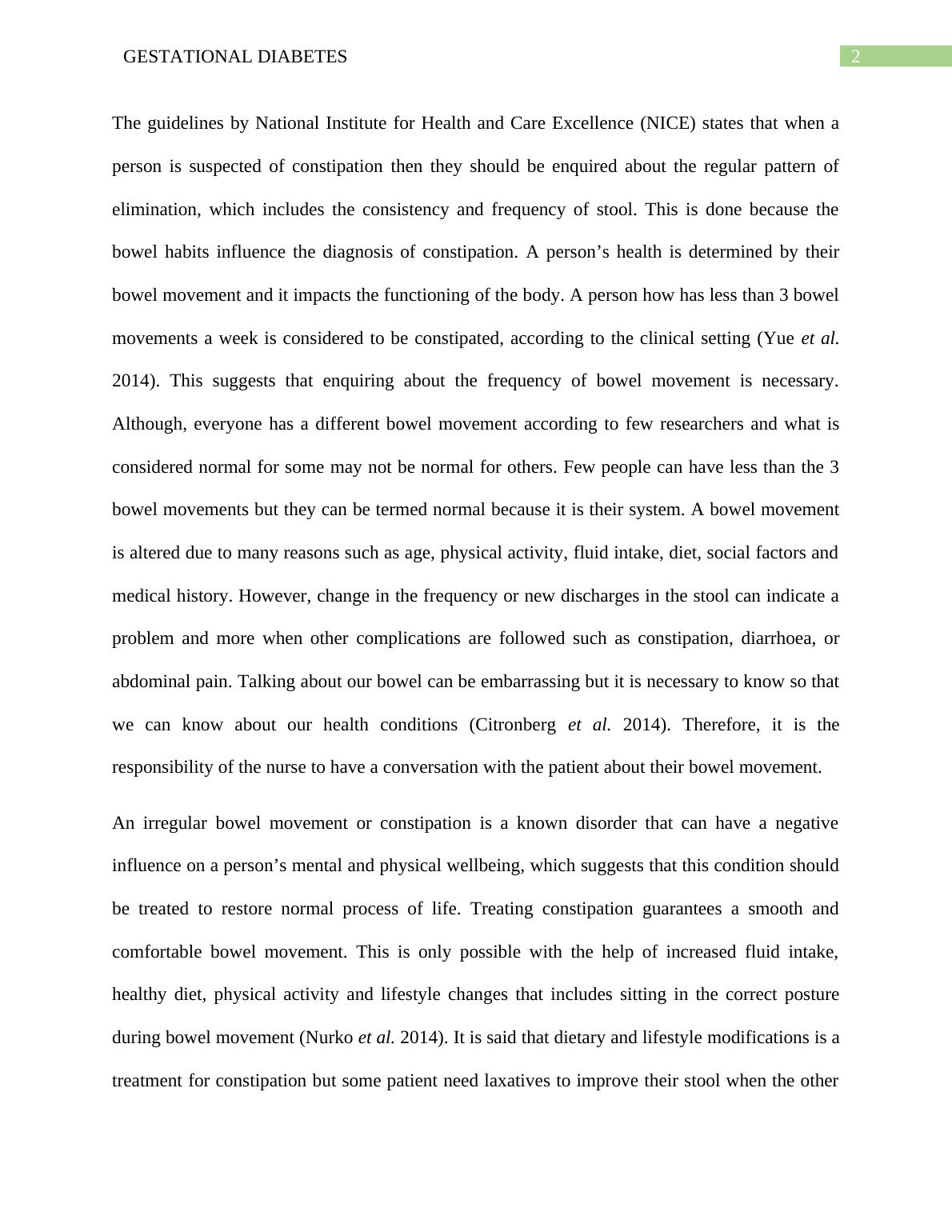Gestational Diabetes - Care Plan and Leaflet Rationale
Added on 2022-08-27
13 Pages3809 Words21 Views
Running Head: RATIONALE
CARE PLAN AND LEAFLET RATIONALE
Name of the Student
Name of the University
Author’s Note
CARE PLAN AND LEAFLET RATIONALE
Name of the Student
Name of the University
Author’s Note

GESTATIONAL DIABETES1
Care Plan:
A care plan for Carole Howard is planned as she is suffering from constipation and according to
the Bristol tool chart she has a type 7 (overflow). She has complained of dissatisfactory bowel
movements for the last 8 week during her consultation. The care plan will begin with an enquiry
session that will get all the information regarding her symptoms and if it will be assessed, if she
has blood discharges in her stool. She will get advice and prescriptions so that her constipation
will decrease. Carole should be given the correct diet to follow that includes optimum amount of
fluid, fibre rich food, an optimum quantity of fruits and vegetables, restricting alcohol and
refined food content in the diet. She should be given a chart to explain the dos and don’ts when
suffering from constipation. She will be prescribed laxatives so that she is able to pass stools
after it has increased in its fluid content.
Care Plan Rationale
Assessment and diagnosis of constipation depends on the symptom that requires
gathering the collection of data regarding medical, surgical, dietary and drug history. Several
challenges are faced by healthcare professionals during the assessment of patients suffering from
constipation, it is not only due to the awkwardness during rectal examination but constipation
has no definite cause. It differs from person to person. It is necessary for nurses to have certain
skills so that they can efficiently assess patients because effective assessment gives relevant
information that can help in planning interventions for disease management (Shah et al. 2104).
Lack of awareness and practice can obstruct correct assessment, which will lead to incorrect
diagnosis and treatment affecting the health of the patient as well as increasing the healthcare
cost.
Care Plan:
A care plan for Carole Howard is planned as she is suffering from constipation and according to
the Bristol tool chart she has a type 7 (overflow). She has complained of dissatisfactory bowel
movements for the last 8 week during her consultation. The care plan will begin with an enquiry
session that will get all the information regarding her symptoms and if it will be assessed, if she
has blood discharges in her stool. She will get advice and prescriptions so that her constipation
will decrease. Carole should be given the correct diet to follow that includes optimum amount of
fluid, fibre rich food, an optimum quantity of fruits and vegetables, restricting alcohol and
refined food content in the diet. She should be given a chart to explain the dos and don’ts when
suffering from constipation. She will be prescribed laxatives so that she is able to pass stools
after it has increased in its fluid content.
Care Plan Rationale
Assessment and diagnosis of constipation depends on the symptom that requires
gathering the collection of data regarding medical, surgical, dietary and drug history. Several
challenges are faced by healthcare professionals during the assessment of patients suffering from
constipation, it is not only due to the awkwardness during rectal examination but constipation
has no definite cause. It differs from person to person. It is necessary for nurses to have certain
skills so that they can efficiently assess patients because effective assessment gives relevant
information that can help in planning interventions for disease management (Shah et al. 2104).
Lack of awareness and practice can obstruct correct assessment, which will lead to incorrect
diagnosis and treatment affecting the health of the patient as well as increasing the healthcare
cost.

GESTATIONAL DIABETES2
The guidelines by National Institute for Health and Care Excellence (NICE) states that when a
person is suspected of constipation then they should be enquired about the regular pattern of
elimination, which includes the consistency and frequency of stool. This is done because the
bowel habits influence the diagnosis of constipation. A person’s health is determined by their
bowel movement and it impacts the functioning of the body. A person how has less than 3 bowel
movements a week is considered to be constipated, according to the clinical setting (Yue et al.
2014). This suggests that enquiring about the frequency of bowel movement is necessary.
Although, everyone has a different bowel movement according to few researchers and what is
considered normal for some may not be normal for others. Few people can have less than the 3
bowel movements but they can be termed normal because it is their system. A bowel movement
is altered due to many reasons such as age, physical activity, fluid intake, diet, social factors and
medical history. However, change in the frequency or new discharges in the stool can indicate a
problem and more when other complications are followed such as constipation, diarrhoea, or
abdominal pain. Talking about our bowel can be embarrassing but it is necessary to know so that
we can know about our health conditions (Citronberg et al. 2014). Therefore, it is the
responsibility of the nurse to have a conversation with the patient about their bowel movement.
An irregular bowel movement or constipation is a known disorder that can have a negative
influence on a person’s mental and physical wellbeing, which suggests that this condition should
be treated to restore normal process of life. Treating constipation guarantees a smooth and
comfortable bowel movement. This is only possible with the help of increased fluid intake,
healthy diet, physical activity and lifestyle changes that includes sitting in the correct posture
during bowel movement (Nurko et al. 2014). It is said that dietary and lifestyle modifications is a
treatment for constipation but some patient need laxatives to improve their stool when the other
The guidelines by National Institute for Health and Care Excellence (NICE) states that when a
person is suspected of constipation then they should be enquired about the regular pattern of
elimination, which includes the consistency and frequency of stool. This is done because the
bowel habits influence the diagnosis of constipation. A person’s health is determined by their
bowel movement and it impacts the functioning of the body. A person how has less than 3 bowel
movements a week is considered to be constipated, according to the clinical setting (Yue et al.
2014). This suggests that enquiring about the frequency of bowel movement is necessary.
Although, everyone has a different bowel movement according to few researchers and what is
considered normal for some may not be normal for others. Few people can have less than the 3
bowel movements but they can be termed normal because it is their system. A bowel movement
is altered due to many reasons such as age, physical activity, fluid intake, diet, social factors and
medical history. However, change in the frequency or new discharges in the stool can indicate a
problem and more when other complications are followed such as constipation, diarrhoea, or
abdominal pain. Talking about our bowel can be embarrassing but it is necessary to know so that
we can know about our health conditions (Citronberg et al. 2014). Therefore, it is the
responsibility of the nurse to have a conversation with the patient about their bowel movement.
An irregular bowel movement or constipation is a known disorder that can have a negative
influence on a person’s mental and physical wellbeing, which suggests that this condition should
be treated to restore normal process of life. Treating constipation guarantees a smooth and
comfortable bowel movement. This is only possible with the help of increased fluid intake,
healthy diet, physical activity and lifestyle changes that includes sitting in the correct posture
during bowel movement (Nurko et al. 2014). It is said that dietary and lifestyle modifications is a
treatment for constipation but some patient need laxatives to improve their stool when the other

GESTATIONAL DIABETES3
methods are ineffective. This is approved by the NICE (2017) guidelines and if the first
treatment is ineffective then oral laxatives should be given in the next step.
The most commonly used medications in constipations are known as laxatives that helps in
promoting bowel movement and it is used for treatment of chronic constipation and management
of mild constipation. However, there is a conflict in literature about laxatives because few
believe that there is no evidence about the benefits of laxative for chronic constipation but
several studies indicate that laxatives are effective for constipation (Candy et al. 2015).
The major groups of laxative are known as osmotic laxatives (movicol, lactulose), faecal
softeners (Docusate sodium), stimulant laxatives (Senna) and bulk-forming laxatives (fybogel).
The function of all these laxatives are to increase the peristalsis that will help in moving the
faeces but all their effects vary. A general practitioner subscribes a laxative according to a
patient’s complaint, compliance, tolerance, acceptability and the time in which the metabolic
reaction will take place (Gordon et al. 2016).
NICE guidelines recommend that a stepped approach is needed for the use of laxatives, which is
the implementation bulk forming laxatives in the initial stage of the treatment because they act as
a dietary fibre that is the reason for the water to be absorbed form the intestinal lumen, which
helps in softening stool consistency and increasing the amount of stool bulk. However, studies
suggest that bulk forming laxatives might not be acceptable by every patient especially in the old
age group because this laxative requires maintenance of high fluid intake in the body as
inadequate fluid can cause impaction. Stimulant laxatives helps in stimulating the nerves that is
required in controlling the digestive tract lining, which increases the bowel movement,
smoothens the tool consistency and escalates the stool frequency. While, osmotic laxatives helps
in increasing the fluid content of the bowel and softens the stool consistency, which makes it
methods are ineffective. This is approved by the NICE (2017) guidelines and if the first
treatment is ineffective then oral laxatives should be given in the next step.
The most commonly used medications in constipations are known as laxatives that helps in
promoting bowel movement and it is used for treatment of chronic constipation and management
of mild constipation. However, there is a conflict in literature about laxatives because few
believe that there is no evidence about the benefits of laxative for chronic constipation but
several studies indicate that laxatives are effective for constipation (Candy et al. 2015).
The major groups of laxative are known as osmotic laxatives (movicol, lactulose), faecal
softeners (Docusate sodium), stimulant laxatives (Senna) and bulk-forming laxatives (fybogel).
The function of all these laxatives are to increase the peristalsis that will help in moving the
faeces but all their effects vary. A general practitioner subscribes a laxative according to a
patient’s complaint, compliance, tolerance, acceptability and the time in which the metabolic
reaction will take place (Gordon et al. 2016).
NICE guidelines recommend that a stepped approach is needed for the use of laxatives, which is
the implementation bulk forming laxatives in the initial stage of the treatment because they act as
a dietary fibre that is the reason for the water to be absorbed form the intestinal lumen, which
helps in softening stool consistency and increasing the amount of stool bulk. However, studies
suggest that bulk forming laxatives might not be acceptable by every patient especially in the old
age group because this laxative requires maintenance of high fluid intake in the body as
inadequate fluid can cause impaction. Stimulant laxatives helps in stimulating the nerves that is
required in controlling the digestive tract lining, which increases the bowel movement,
smoothens the tool consistency and escalates the stool frequency. While, osmotic laxatives helps
in increasing the fluid content of the bowel and softens the stool consistency, which makes it

End of preview
Want to access all the pages? Upload your documents or become a member.
Related Documents
Nursing Care Client Assessment - Case Studylg...
|15
|3526
|37
ISBAR Plan of Care | Pain and Loss of Bloodlg...
|4
|584
|202
Sally Mae Home Visitlg...
|3
|856
|37
Health Concepts in Nursing | Case Studylg...
|9
|2339
|14
Clinical Diagnosis: A Case Study of Lower Abdominal Painlg...
|15
|3058
|93
Diagnostic and clinical reasoning paper Assignment1lg...
|9
|1494
|13
